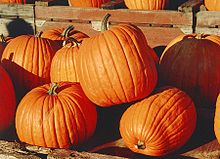This is an old revision of this page, as edited by 68.198.189.173 (talk) at 17:31, 29 September 2006 (→Cultivation). The present address (URL) is a permanent link to this revision, which may differ significantly from the current revision.
Revision as of 17:31, 29 September 2006 by 68.198.189.173 (talk) (→Cultivation)(diff) ← Previous revision | Latest revision (diff) | Newer revision → (diff)- For the film, see Pumpkin (film).


A pumpkin is a squash fruit, most commonly orange in colour when ripe. Pumpkins grow as a gourd from a trailing vine of the genus Cucurbita Cucurbitaceae. Cultivated in North America, continental Europe, and some other countries, as well as in English cottage gardens, Cucurbita varieties include Curcurbita pepo, Cucurbita maxima, Cucurbita mixta, or Cucurbita moschata — all plants native to the Western hemisphere. The pumpkin varies greatly in form, being sometimes nearly globular, but more generally oblong or ovoid in shape. The rind is smooth and variable in colour. The larger kinds acquire a weight of 40 to 80 lb (18 to 36 kg) but smaller varieties are in vogue for garden culture. Pumpkins are a popular food, with their innards commonly eaten cooked and served in dishes such as pumpkin pie. Pumpkins are traditionally used to carve Jack-o'-lanterns for use as part of Halloween celebrations.
Botanically it is a fruit, referring to a certain plant part which grows from a flower. However it is widely regarded as a vegetable in culinary terms, referring to how it is eaten.
Butternut squash is called "butternut pumpkin" in Australia, and "neck pumpkin" in parts of Pennsylvania where it is commonly regarded as a pumpkin and used in similar ways to other pumpkin.
Cultivation
Chunking
Pumpkin chunking is a competitive activity in which teams build various mechanical devices designed to throw a pumpkin as far as possible. Catapults, trebuchets, ballistas and air cannons are the most
Pumpkin seeds
The hulless or semi-hulless seeds of pumpkins can be roasted and eaten as a snack, similar to the sunflower seed. They are a good source of essential fatty acids, potassium, and magnesium. In Latin America these are often greenish in color and known as pepitas. One of the typical pumpkin products of Austria is pumpkin seed oil.
Photo of pumpkin seed of different kinds: http://www.pamsee.com/engl/photo-sample.htm
Cooking
When ripe, the pumpkin can be boiled, baked and roasted, or made into various kinds of pie, alone or mixed with other fruit; while small and green it may be eaten in the same way as the vegetable marrow.
Pumpkin trivia
[[* Pumpkins were among the first foods from the "New World" adopted in Europe, probably due to a European cousin: Lagenaria
- "Pumpkin" is sometimes used as an affectionate term, often referring to one's significant other. For example: "I love you, Pumpkin."
- The pumpkin is the state fruit of New Hampshire.
See also
References
- Illinois Leads Nation in Pumpkin Production, Illinois Department of Agriculture.
- The Largest Pumpkin Ever, bigpumpkins.com.
- Keene Pumpkin Festival, list of world records.
External links
Festivals and Shows:
- The Barnesville Pumpkin Festival
- The Bradford Pumpkin Show
- The Circleville Pumpkin Show
- The Keene Pumpkin Festival
Pumpkin Carving:
Information on pumpkin varieties
- Pumpkin Varieties - backyardgardener.com, site focused on North-Eastern USA.
- April 2004 – In season describes several varieties available in Australia.
- Pumpkins - Lots and lots of Varieties! - American pumpkin varieties, arranged by species.
- Squashes and Pumpkins - Oregon State University. Arranged by species.